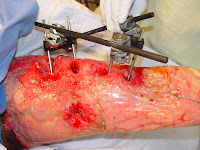I started off the past week with a Monday morning lecture on lower extremity wounds. Dr. Spector gave the lecture which was followed by case reviews for the residents. This was very interesting to watch because the reviews allowed insight into the entire diagnosis and treatment process; describing from when a patient presents with a particular case, noting what knowledge is important to gain about the patient in order to make a proper decision, and finally how to treat the patient and what should be done when obstacles are confronted.
During office hours I saw a burn patient that Dr. Spector has been treating. The patient has scaring all over his face and upper torso which is disfiguring, painful, and prevents proper function. Around his mouth and neck the scarring has hardened so that he is not able to fully open is mouth or rotate his head. In addition, his nose is no longer symmetric which Dr. Spector plans to alter by removing cartilage and skin from his nose to reform the nostril. In addition, I saw quite a few cosmetic consults during office hours where Dr. Spector discusses the desired alterations a patient may want to his or her body including breast augmentations, rhinoplastys, or liposuction. I also met a patient that Dr. Spector performed a breast augmentation for a few years ago and recently one breast has enlarged and become painful as the fibrous tissue scarring has begun to contract. This is a known complication to breast augmentation. In order to fix the problem, the patient will have to undergo surgery to remove the fibrous tissue.
I have also seen some interesting cases in the OR. Prior to my arrival, a patient was admitted after being struck by a vehicle. The resultant injuries required that her femur be externally fixed as seen in the images below to allow fo






No comments:
Post a Comment